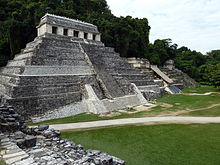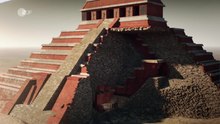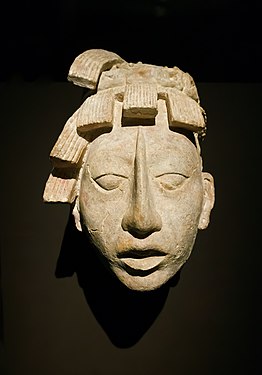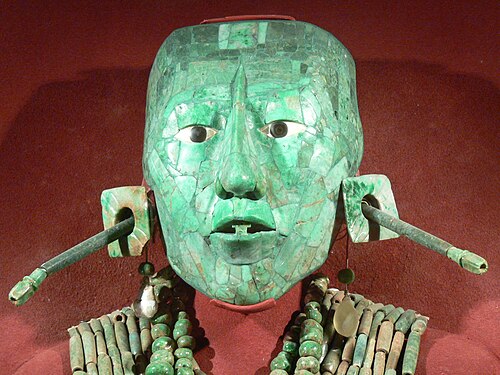Temple of the Inscriptions
The Temple of the Inscriptions ( Spanish Templo de las Inscripciones ) is a central building in the Maya city of Palenque in the Mexican state of Chiapas not far from the modern city of Palenque . It was built at the end of the 7th century as the tomb of the ruler ( Ajaw ) K'inich Janaab Pakal I (also Pakal the Great ). Construction began while Pakal was still alive and was completed under his son and successor, K'inich Kan Bahlam II . In 1952, during archaeological excavations led by Alberto Ruz Lhuillier, Pakal's burial was found untouched in the burial chamber . This find refuted the prevailing view that the Mayan pyramids were exclusively temples.
location
The Temple of the Inscriptions is on the south side of a central square in Palenque. Connected to it are the two buildings to the west, known as " Temple XIII " and " Temple XII " (also known as "Temple of the Skull"). In Temple XIII a woman was buried who, due to a lack of inscriptions, was called the Red Queen (Spanish Reina Roja ) by the excavators and who is probably Pakal's wife Tz'akbu Ajaw . The east side of the square is occupied by the palace , the west side by " Temple XI ". The north side of the square is undeveloped.
architecture

The pyramid
The base of the temple is a stepped pyramid with a rectangular base. It consists of stone blocks and is divided into eight levels. From the middle of the north side a staircase leads up to a platform. The staircase consists of 60 steps, which are divided into four groups of 9, 19, 19 and 13 steps each. The actual temple sits enthroned on this platform on a further substructure. Another 9-step landing, framed by cheeks , leads to its entrance .
The temple
The temple has a floor plan of 22 mx 7 m and, like the pyramid, is built from stone blocks. Its northern facade has six pillars, of which the middle are free-standing and the outer ones border on the narrow sides of the temple. The five spaces between the pillars provide access to a single corridor that spans the width of the temple. From here three passages lead to three more rooms. All rooms are crowned by a high cantilever vault . At the end of the temple is a mansard roof , which was originally crowned by a mighty ridge, but only remnants have been preserved. The six pillars on the facade are decorated with stucco reliefs, as are the areas to the left and right of the access to the central rear room and its rear wall. Presumably the entire temple and its substructure were once covered with stucco painted in red; however, nothing of this has survived.
The crypt
From the middle rear room, a staircase spanned by several offset cantilever vaults leads down to the substructure in a westward direction. It opens into an antechamber and from there continues in an easterly direction to the actual burial chamber. It is located 26 m below the temple and 2 m below the natural ground level. When it was discovered, it was locked with a rotating, triangular stone door. The chamber has a length of 9 m and a width of 4 m. Their long sides each have a projection that encompasses their middle thirds. The back has a double recessed niche. The chamber is almost entirely occupied by Pakal's mighty stone sarcophagus .
Reliefs and inscriptions
The facade
The inscription above the pillars
Of the original 44 characters in this inscription, only six have survived. Two dates can be reconstructed from them: The first date denotes a day in December 688 or January 689, the second refers to a day between December 676 or January 677. According to a suggestion by Linda Schele and Peter Matthews, both dates could begin with the construction of the temple. The second date would therefore relate to the start of construction and the first to its inauguration. So there would have been exactly twelve years between the two events.
Pillar A
Pillar A originally had a hieroglyphic inscription consisting of 93 characters. It is so badly damaged that only nine characters can be recognized and the content of the text can consequently only be reconstructed extremely fragmentarily. The inscription begins with a date, of which only the last sign has survived. There are more fragments of dates, a sign for "capture" and a sign for "death"; the latter presumably refers to the death of Pakal.
Pillar B
The four central pillars have pictorial reliefs with a uniform structure. All show a life-size human figure, facing the central entrance of the temple, offering an incense. All figures stand on a monster mask, which represents a mythological site. The figures hold a baby in one arm, who is Unen K'awiil or "God GII", one of the three city gods Palenques. A comparison with the representation on the sarcophagus lid suggests that it is actually Pakal, who is to be reborn in the afterlife as a rejuvenated city god. The person acting on pillar B can be identified by name by glyphs in his headdress: It is therefore K'uk 'Bahlam I , the founder of the Palenque dynasty.
Pillar C
Because of the severe erosion of the relief, the person on pillar C can no longer be clearly identified. However, from the clothing you can see that it is a woman. It is therefore most likely that it is Pakal's mother Sak K'uk ' .
Pillar D
The person on pillar D can also no longer be clearly identified. Your head is completely destroyed. A representation of Pakal's father K'an Mo 'Hix is suspected here parallel to pillar C. Although he never ruled Palenque himself, here, as on the sarcophagus, he is endowed with a full emblematic glyph of Palenque, which was otherwise only used for rulers.
Pillar E
The person on Pillar E can be identified by hair ornament glyphs as a ruler named Kan Bahlam . So it is either Kan Bahlam I. or Pakal's son K'inich Kan Bahlam II.
Pillar F
The hieroglyphic inscription on pillar F originally consisted of 96 characters. Only four have survived, mentioning the name and title of K'inich Kan Balam II. Presumably this inscription represents the counterpart to the inscription on pillar A and reported the deeds of K'inich Kan Balam II, while that one was dedicated to the deeds of his father. Despite the largely destroyed text, an interesting detail can be read from the inscription: K'inich Kan Balam II is referred to here as the tenth ruler of Palenque. But since twelve rulers are known by name who ruled before him, three rulers were apparently viewed as illegitimate at that time. From a list of rulers in the Temple of the Cross it can be seen that these were Yohl Ik'nal , Ajen Yohl Mat and Muwaan Mat , the three immediate predecessors of Pakal.
The stairs
Two more reliefs have been preserved on the sides of the stairs that lead from the platform of the pyramid into the temple. Both show human figures that were originally interpreted as prisoners. However, since they do not wear any shackles, but instead have large jewelry, they should not be regarded as such. Both figures wear calendar glyphs that are too badly eroded to be clearly deciphered. The meaning of these two dates is so far unclear.
The inscriptions inside the temple
The eastern inscription panel
The detailed inscription on the eastern panel is an important source for the reconstruction of the history of the Palenque rulership. It is complete for all rulers of Palenques from Ahkal Mo 'Nahb I. (the fourth ruler) to K'inich Janaab Pakal I. die exact dates of their accession to the throne and important religious ceremonies. Two entries that deviate from the usual scheme are of particular interest: The first relates to the rule of Ajen Yohl Mat. First there is a passage in which apparently it is about the fact that celebrations at the end of a calendar cycle could not take place. Immediately thereafter, without reference to a ruler, the mention of the capture of Palenques by the warring city-state of Calakmul follows . The second entry concerns Muwaan Mat, whose identity has not yet been clarified with certainty. The entry begins with the passage “The mistress was lost, the master was lost.” The exact meaning of the sentence is unclear; presumably it refers to an extinction of the main line of the ruling house, whereupon Muwaan Mat was installed as regent. As a result of this, further important religious celebrations were canceled.
The middle inscription panel
The middle panel describes in great detail the religious ceremonies performed by Pakal. The only other event mentioned is a war against the masters of the East and the West. This should be a reference to the successful campaign against Pomoná and Santa Elena in 659.
The western inscription tablet
The western inscription begins with several religious ceremonies performed by Pakal. What follows is a somewhat problematic passage in which reference is made to future events: On the one hand, to the end of the calendar cycle 9.13.0.0.0 (March 3, 692), which fell during the reign of K'inich Kan Balam II, on the other hand to an event in the distant future, namely the completion of a pictun (1.0.0.0.0.0) in the year 4772. This is followed by exact dates for Pakal's birth and his accession to the throne. This is followed by other passages that refer to future events.
The second half of the inscription leads back to Pakal's reign and begins with a detailed description of the arrival and ritual sacrifice of Nu'n u Jol Chaahk , the ruler of Santa Elena captured in 659. The arrival and sacrifice of another prisoner is described, embedded in some unclear references to the more recent and the mythological past. A section follows detailing the dates of Pakal's wedding to Tz'akbu Ajaw and her death. The inscription ends with dates for Pakal's last celebration at the end of a calendar cycle, for his death, and for his son's accession to the throne.
The grave and its furnishings
Grave goods and burials in front of the burial chamber
Access to the burial chamber was originally blocked by two stone walls. Behind the first, Lhuillier discovered a chest made of stone slabs connected by mortar. It contained seven club heads made of jade , two flower-shaped jade ear stakes , a teardrop-shaped pearl earring and three seashells with red paint. Behind the second wall, Lhuillier found another, larger box. This contained no additions, but the skeletons of five people of both sexes who were supposed to accompany Pakal into the afterlife.
The additions in the burial chamber
Under the sarcophagus, Lhuillier found two stucco heads, which are probably images of Pakal. The smaller one is 29 cm high and shows the ruler at a young age. The second head is 43 cm high and shows Pakal as a grown man.
Reconstruction of the burial chamber in the National Museum of Anthropology , Mexico City
The sarcophagus
The sarcophagus, which almost completely occupies the burial chamber, is carved from a single block of stone and weighs 15 tons. A grave slab 3.8 m long and 2.2 m wide rests on it. It has a weight of 5.5 tons. On its side faces, it has an inscription that begins with the dates of birth and death of Pakal and then continues with the dates of the death of his predecessors. This list includes all rulers from Ahkal Mo 'Nahb I. to Ajen Yohl Mat. Muwaan Mat was omitted. Instead, Pakal's grandfather Janaab Pakal and his parents Sak K'uk 'and K'an Mo' Hix are performed.
The top of the plate shows the transition from Pakal to the Xibalba underworld . The central motif is the world tree Wacah Chan . At his feet Pakal lies with his legs drawn up and is swallowed up by the underworld, which is depicted as a skull with its mouth wide open. Between Pakal and the teeth of the underworld, however, there is still a protective symbol: It is a partially skeletonized monster head that carries a sacrificial bowl with the sun hieroglyph. This sign was supposed to enable Pakal to wander safely through the underworld and finally to rise again on the eastern horizon.
Pakal's corpse and its furnishings
Pakal's body was adorned with numerous pieces of jade jewelry. There was a mask on his face. The dead man's eyes are modeled on mother-of-pearl and obsidian. In his mouth he wore a T-shaped amulet. Long ear pegs lay next to the mask. Several chains of variously shaped pearls were wrapped around his neck and wrists. There was a ring on each finger. There were also two jade heads. The first is a portrayal of Pakal at an advanced age. The second head is an image of the sun god.
literature
General representations
- Guillermo Bernal Romero : El señorío de Palenque durante la Era de K'inich Janaahb 'Pakal y K'inich Kan B'ahlam (615-702 dC). Universidad Nacional Autónoma de México, Histomesoamericana, 2011 ( PDF; 0.7 MB ).
- Nikolai Grube (Ed.): Maya. God kings in the rainforest. Könemann-Verlag, Cologne 2000, ISBN 3-8290-1564-X .
- Deborah Kops: Palenque. Unearthing Ancient Worlds. Twenty-First Century Books, Minneapolis 2008, ISBN 978-0-7613-4047-8 .
- Linda Schele , David Freidel : The unknown world of the Maya. Weltbild Verlag, Augsburg 1995, ISBN 3-89350-737-X .
- Henri Stierlin : Maya. Palaces and pyramids in the jungle. Taschen, Cologne 2001, ISBN 3-8228-1240-4 , pp. 77-84.
- David Stuart , George Stuart : Palenque. Eternal City of the Maya. Thames & Hudson, London 2008, ISBN 978-0-50-00-5156-6 , pp. 166-184.
Excavation reports and evaluations
- Alberto Ruz Lhuillier : Exploraciones arqueológicas en Palenque (1949) In: Anales del Instituto Nacional de Antropología e Historia. Volume 4, No. 32, 1952, pp. 49-60.
- Alberto Ruz Lhuillier: Exploraciones en Palenque: 1951 In: Anales del Instituto Nacional de Antropología e Historia. Volume 5, No. 33, 1952, pp. 47-66.
- Alberto Ruz Lhuillier: Exploraciones arqueológicas en Palenque, 1954 In: Anales del Instituto Nacional de Antropología e Historia. Volume 10, No. 39, 1958, pp. 117-184.
- Alberto Ruz Lhuillier: El Templo de las Inscripciones, Palenque (= Colección Científica. Volume 4). Mexico City 1952.
- Elaine Day Schele: The Untold Story of Alberto Ruz and his Archaeological Excavations at Palenque, México: A Micro- and Macrohistorical Approach. Dissertation, The University of Texas, Austin 2012 ( PDF; 21.4 MB ).
Inscriptions and plastic
- Stanley Guenter : The Tomb of K'inich Janaab Pakal: The Temple of the Inscriptions at Palenque. In: Mesoweb Articles. Mesoweb ( PDF; 4.37 MB ).
- Merle Greene Robertson : The Sculpture of Palenque. Volume I: The Temple of Inscriptions. Princeton University Press, Princeton 1983.
anthropology
- Vera Tiesler , Andrea Cucina (eds.): Janaab 'Pakal of Palenque: Reconstructing the Life and Death of a Maya Ruler. The University of Arizona Press, Tucson 2006, ISBN 978-0816525102 ( online limited version ).
Web links
- mesoweb.com - The Temple of the Inscriptions (engl.)
- mesoweb.com - Who is buried in Pakal's tomb?
- Tumba de Pakal sorprende en Museo de Antropología (span.)
- Descubren sistema de canales bajo el Templo de las Inscripciones de Palenque (span.)
Individual evidence
- ↑ a b mesoweb.com - The Temple of the Inscriptions
- ^ A b c Henri Stierlin: Maya. Palaces and pyramids in the jungle. Taschen, Cologne 2001, p. 77.
- ↑ Linda Schele , Peter Matthews: The Code of Kings: The Language of Seven Sacred Maya Temples and Tombs. Scribner, New York 1998, p. 100.
- ^ Stanley Guenter: The Tomb of K'inich Janaab Pakal: The Temple of the Inscriptions at Palenque. Pp. 3-4.
- ^ Stanley Guenter: The Tomb of K'inich Janaab Pakal: The Temple of the Inscriptions at Palenque. P. 2.
- ^ Stanley Guenter: The Tomb of K'inich Janaab Pakal: The Temple of the Inscriptions at Palenque. Pp. 4-5.
- ^ Stanley Guenter: The Tomb of K'inich Janaab Pakal: The Temple of the Inscriptions at Palenque. P. 5.
- ^ Stanley Guenter: The Tomb of K'inich Janaab Pakal: The Temple of the Inscriptions at Palenque. Pp. 5-6.
- ^ Stanley Guenter: The Tomb of K'inich Janaab Pakal: The Temple of the Inscriptions at Palenque. P.56.
- ^ Stanley Guenter: The Tomb of K'inich Janaab Pakal: The Temple of the Inscriptions at Palenque. Pp. 2-3.
- ^ Stanley Guenter: The Tomb of K'inich Janaab Pakal: The Temple of the Inscriptions at Palenque. P. 6.
- ^ Stanley Guenter: The Tomb of K'inich Janaab Pakal: The Temple of the Inscriptions at Palenque. Pp. 7-25.
- ^ Stanley Guenter: The Tomb of K'inich Janaab Pakal: The Temple of the Inscriptions at Palenque. Pp. 25-37.
- ^ Stanley Guenter: The Tomb of K'inich Janaab Pakal: The Temple of the Inscriptions at Palenque. Pp. 38-46.
- ^ Stanley Guenter: The Tomb of K'inich Janaab Pakal: The Temple of the Inscriptions at Palenque. Pp. 46-55.
- ↑ Deborah Kops: Palenque. Unearthing Ancient Worlds. Twenty-First Century Books, Minneapolis 2008, pp. 40-41.
- ↑ Deborah Kops: Palenque. Unearthing Ancient Worlds. Twenty-First Century Books, Minneapolis 2008, pp. 41-43.
- ^ Henri Stierlin: Maya. Palaces and pyramids in the jungle. Taschen, Cologne 2001, p. 79.
- ^ Henri Stierlin: Maya. Palaces and pyramids in the jungle. Taschen, Cologne 2001, pp. 76, 79.
- ^ Stanley Guenter: The Tomb of K'inich Janaab Pakal: The Temple of the Inscriptions at Palenque. Pp. 55-62.
- ↑ Linda Schele, David Freidel: The unknown world of the Maya. Weltbild Verlag, Augsburg 1995, p. 252.
- ↑ Deborah Kops: Palenque. Unearthing Ancient Worlds. Twenty-First Century Books, Minneapolis 2008, pp. 56-57.
- ^ Henri Stierlin: Maya. Palaces and pyramids in the jungle. Taschen, Cologne 2001, pp. 79-80.
Coordinates: 17 ° 29 ′ 1 ″ N , 92 ° 2 ′ 48.5 ″ W.















